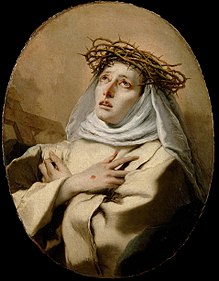
Back كاترينا من سيينا Arabic كاترينا من سيينا ARZ Catalina de Siena AST Caterina da Siena Aymara Кацярына Сіенская Byelorussian Катерина Сиенска Bulgarian Katelin Siena Breton Caterina de Siena Catalan Kateřina Sienská Czech Katharina von Siena German
Catherine of Siena | |
|---|---|
 St. Catherine of Siena, by Giovanni Battista Tiepolo | |
| Virgin, Doctor of the Church | |
| Born | Caterina di Jacopo di Benincasa 25 March 1347 Siena, Republic of Siena |
| Died | 29 April 1380 (aged 33) Rome, Papal States |
| Venerated in | |
| Beatified | 29 December 1460 |
| Canonized | 29 April 1461 by Pope Pius II |
| Major shrine | Santa Maria sopra Minerva, Rome and the Sanctuary of Saint Catherine, Siena |
| Feast | 29 April; 30 April (Roman Calendar, 1628–1969); 4 October (in Italy) |
| Attributes | habit of a Dominican tertiary, ring, lily, cherubim, crown of thorns, stigmata, crucifix, book, heart, skull, dove, rose, miniature church, miniature ship bearing papal coat of arms |
| Patronage | against fire; bodily ills; people ridiculed for their piety; nurses; sick people; miscarriages; Europe; Italy; Diocese of Allentown, Pennsylvania, U.S.; Bambang, Nueva Vizcaya, Philippines; Samal, Bataan, Philippines |
Caterina di Jacopo di Benincasa, TOSD (25 March 1347 – 29 April 1380), known as Catherine of Siena (Italian: Caterina da Siena), was an Italian Catholic mystic and pious laywoman who engaged in papal and Italian politics through extensive letter-writing and advocacy. Canonized in 1461, she is revered as a saint and as a Doctor of the Church due to her extensive theological authorship. She is also considered to have influenced Italian literature.
Born and raised in Siena, Catherine wanted from an early age to devote herself to God, against the will of her parents. She joined the "mantellates", a group of pious women, primarily widows, informally devoted to Dominican spirituality; later these types of urban pious groups would be formalized as the Third Order of the Dominicans, but not until after Catherine's death.[3] She dictated to secretaries her set of spiritual treatises, The Dialogue of Divine Providence.
Her influence with Pope Gregory XI played a role in his 1376 decision to leave Avignon for Rome. The Pope then sent Catherine to negotiate peace with the Florentine Republic. After Gregory XI's death (March 1378) and the conclusion of peace (July 1378), she returned to Siena. The Great Schism of the West led Catherine of Siena to go to Rome with the pope. She sent numerous letters to princes and cardinals to promote obedience to Pope Urban VI and to defend what she calls the "vessel of the Church". She died on 29 April 1380, exhausted by her rigorous fasting. Urban VI celebrated her funeral and burial in the Basilica of Santa Maria sopra Minerva in Rome.
Devotion around Catherine of Siena developed rapidly after her death. Pope Pius II canonized her in 1461; she was declared a patron saint of Rome in 1866 by Pope Pius IX, and of Italy (together with Francis of Assisi) in 1939 by Pope Pius XII.[4][5][6][7][8] She was the second woman to be declared a Doctor of the Church, on 4 October 1970 by Pope Paul VI – only days after Teresa of Ávila. In 1999 Pope John Paul II proclaimed her a Patron Saint of Europe.
- ^ "Holy Men and Holy Women" (PDF). Churchofengland.org. Archived (PDF) from the original on 7 September 2012.
- ^ "Notable Lutheran Saints". Resurrectionpeople.org. Archived from the original on 16 May 2019. Retrieved 16 July 2019.
- ^ Longo, F. Thomas (2006). "Cloistering Catherine: Religious Identity in Raymond of Capua's Legenda Maior of Catherine of Siena". Studies in Medieval and Renaissance History. 3: 25–69.
- ^ Haegen, Anne Mueller von der; Strasser, Ruth F. (2013). "St. Catherine of Siena: Mystic, Politician, and Saint". Art & Architecture: Tuscany. Potsdam: H.F.Ullmann Publishing. p. 334. ISBN 978-3-8480-0321-1.
- ^ (in Italian) Pope Pius XII, Pontifical Brief, 18 June 1939.
- ^ (in Italian) Proclamation to Doctor of the Church, Homily, 4 October 1970.
- ^ Proclamation of the Co-Patronesses of Europe, Apostolic Letter, 1 October 1999. Archived 20 November 2014 at the Wayback Machine
- ^ Liturgical Feast of St. Bridget, Homily, 13 November 1999.